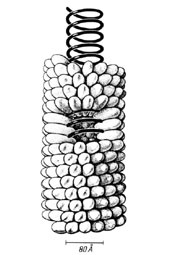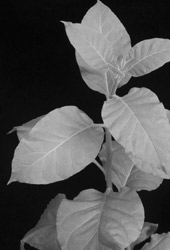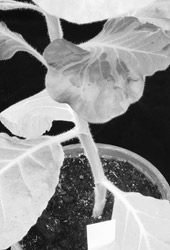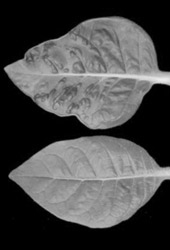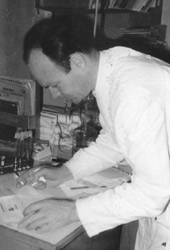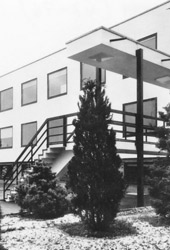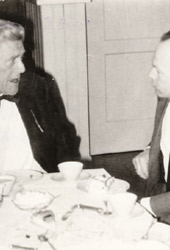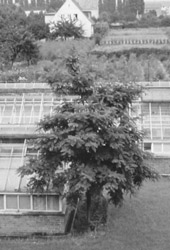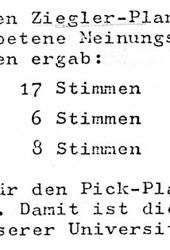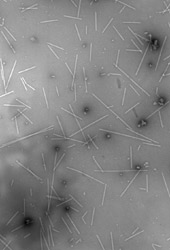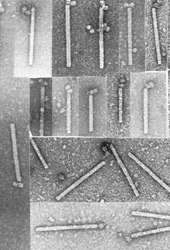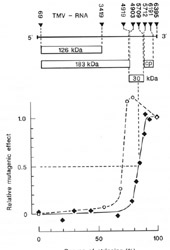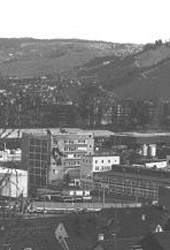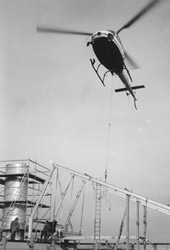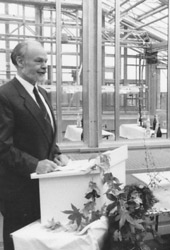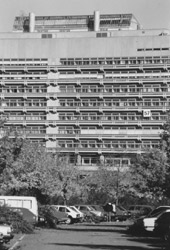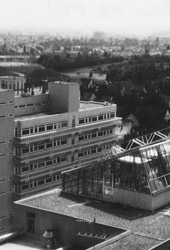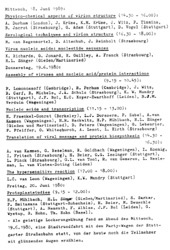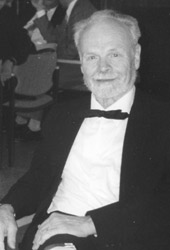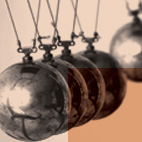 |
|
||||||||||||||||||||||||||||||||
|
|||||||||||||||||||||||||||||||||
|
Research on the tobacco mosaic virus By Wiebke Herr You may be familiar with the fruit fly, Drosophila melanogaster, an insect that plays an important role in genetic research. But have you ever heard of the tobacco mosaic virus? Did you know that it is equally an important model organism in virology and molecular biology? Follow the virus on its exciting journey to and around Stuttgart!
The virus on its way to GermanyThe tobacco mosaic virus (TMV) had long been a familiar object of research in other countries before it became the focus of interest in Germany in 1935. Moreover, the tobacco mosaic virus had already been identified as the first non-bacterial pathogen. This discovery marked the beginning of the science of virology.
The viral puzzle beginsIt is no coincidence that at the end of the 19th century attention was focussed on the causes of tobacco plant diseases. Following a devastating tobacco disease, the German bacteriologist Adolf Mayer tried to establish a standard for the pattern of the disease in Holland. In 1886 he described its typical pathological chequered leaf pattern, which led him to coin the term tobacco mosaic disease, and postulated a bacterium as the cause of the disease. Then Dimitri Iosifovich Ivanovski (1892) and Mayer's colleague Martinus Willem Beijerinck (1898) independently observed that the pressed juice of infected plants remained infectious even when passed through established bacteria filters. Whereas Ivanovski thought that a very small bacterium was the cause of the disease, Beijerinck was the first to speak of a virus (for the modern definition of a virus see chapter 4). Yet he was a long way from clarifying exactly what criteria distinguished it from a bacterium. He believed that finer filters would provide an answer; the results of diffusion experiments also suggested, to his mind, that a dissolved substance was involved.
The chemical nature of the virusDo viruses actually constitute a separate category from bacteria? Are they living or non-living organisms? The first important step towards revealing the virus's true nature was to isolate it. In 1935 the American scientist Wendell Stanley succeeded in doing this in a crystallisation process. He claimed that the isolated virus consisted of pure protein. He believed that the reproduction of the virus that occurs at the end of an infection was a kind of self-accelerating chemical process (auto-catalysis). Stanley was thus credited with the "discovery of the chemical nature of viruses". It caused a stir throughout the world, including Berlin.
The virus reaches BerlinSince 1937 what was initially loose cooperation in viral research had begun to take on a clearer profile. Finally, in 1941 the Workshop for Virus Research was founded at the Kaiser Wilhelm Institutes for Biochemistry and Biology. The group took the tobacco mosaic virus as its model organism. Stanley's virus crystals provided the incentive to investigate the protein-based “building blocks” more closely. Georg Melchers, for instance, compared naturally occurring variants of the tobacco mosaic virus. Gerhard Schramm's experiments indicated that the infection did not originate from the protein at all. As early as 1936 two British scientists had found components of ribonucleic acid (RNA) in addition to protein in the tobacco mosaic virus. The Berlin group was also experimenting on TMV. Yet as they still firmly believed that Stanley was right in his assumptions, it was in Tübingen that the infectious effect was first demonstrated – the second stage of the virus on its journey to Stuttgart. Background information: Workshop for Virus Research As all Kaiser Wilhelm institutes in Berlin and Brandenburg had been declared important military institutions in December 1939, the workshop, which was shared by two Berlin Kaiser Wilhelm institutes, was also able to continue its fundamental research during the war.
A stopover in TübingenAfter the Second World War, Tübingen became the centre of tobacco mosaic virus research for around two decades. Karl-Wolfgang Mundry was also involved in work there, and later took the virus to Stuttgart. His proof of the virus's mutability was a milestone in plant virology and molecular biology.
Institutional reorganisationAfter the Second World War the Berlin Workshop for Virus Research was merged with the Max Planck Institute for Virus Research in Tübingen. Some of the staff stayed on. Schramm was one of the founding directors and in 1956 together with Alfred Gierer was finally able to demonstrate the infectious nature of ribonucleic acid. Melchers, on the other hand, was soon made one of the directors at the Max Planck Institute for Biology, which was also based in Tübingen. He had not lost his interest in the tobacco mosaic virus either. Thus the virus was at home in two Tübingen institutions at the same time. Background information: Max Planck Institute for Virus Research Founded in 1954. Founding directors: Hans Friedrich Freksa, Gerhard Schramm and Werner Schäfer. In 1984 it was renamed Max Planck Institute for Developmental Biology.
Mundry meets the virusNow the figure of Karl-Wolfgang Mundry, who was later to play a key role in Stuttgart, took to the scientific stage. Having studied Botany for 6 semesters in Göttingen, his fascination with the question as to the nature of viruses took him to Melchers in Tübingen. Late in the summer of 1949 he cycled around 600 km to talk to Melchers. The effort paid off: from 1950 onwards Mundry was able to work as a PhD student in Melchers' laboratory. He had soon found a research question for his thesis: Can virus mutability be influenced empirically? Naturally occurring mutations of virus strains were the starting point for his research. In an attempt to increase the mutation rate, Mundry exposed the tobacco mosaic virus to x-rays and UV radiation, but without success. Thus in a second series of experiments he changed the conditions: he now used the entire plant host (in vivo conditions) and simply exposed it to a higher culture temperature. This actually did increase the mutation rate. This result formed the conclusion of Mundry's PhD thesis in 1954. Background information: in vivo Within a living organism. Opposite of in vitro, under artificial conditions, strictly speaking: in cell-free conditions
The mutability "atom"In 1958 Mundry finally managed to create in vitro mutations. At the time he was working in Tübingen again as Melchers' assistant after having spent some time working at the Brunswick College of Technology. The new discovery was the high point of his work in Tübingen and was the product of his cooperation with Alfred Gierer from the Max Planck Institute for Virus Research. Beforehand, Schramm and Heinz Schuster had been able to show that a random change in a single component of the nucleic acid (nucleotides) was enough to make the virus fail to function. In their experiments they had used nitrous acid. Mundry and Gierer adopted this technique and demonstrated that a chemical change to a single nucleotide was not necessarily "fatal". Instead, it depended on which one of the over 6000 nucleotides was changed. This meant that they had discovered the smallest unit of mutation. The tobacco mosaic virus was thus no longer just a model for virology, but was also a potential genetic model for molecular biology as a whole. Background information: nucleotides The building blocks of nucleic acid. Each nucleotide consists of three parts: a base (a ring containing nitrogen), a sugar and phosphoric acid. In RNA (ribonucleic acid) the bases are adenine, cytosine, guanine and uracil. Background information: nitrous acid When treated with nitrous acid (in this case alkaline nitrite in a slightly acidic medium), the bases adenine, cytosine and guanine, which are members of the amino base family, are converted into hypoxanthine, uracil and xanthine. These are members of the hydroxy base family.
A university makes plans
In 1870 the Biology Section at Stuttgart Polytechnic separated teaching into two independent disciplines: zoology and botany were taught by two different people for the first time. That year the experimental physicist Heinz Pick took the initiative and devised a plan for Biology as part of a general expansion of teaching staff. This so-called Pick Plan also envisaged a new profile for the subject – with a focus on molecular biology.
But there was opposition to this plan. As the university also offered courses for future secondary school teachers, many considered it important that classical organismic biology should also be covered, and a counter-proposal was drawn up. When the majority voted for the Pick Plan, new appointments were made to the Chair of Zoology and the newly created Chair of Animal Physiology, and also to the Chair of Botany. The latter had been headed by Karl-Wolfgang Mundry, the tobacco mosaic virus specialist, since 1972 . His chair was originally named "Cell Biology II" to distinguish it from zoology. Yet it was only when it was renamed "Molecular Biology and Plant Virology" after he was given emeritus status that the name properly reflected its research focus.
In the years that followed, the ambitious Pick Plan was implemented less and less. Drastic cost-cutting measures forced the university to abandon the strict plan in order to be able to fill the few remaining professorships. Background information: Biology For a long time Biology was not an independent discipline. Into the 19th century the discipline of Natural History was composed only of Zoology, Botany, and Mineralogy. Background information: Pick Plan The following excerpt shows how generous the proposals for personnel and facilities were that the Pick Plan of 13 November 1969 envisaged: "The 'Life Sciences' Section is subdivided into 8 Research Groups (Chairs), and each of the Research Groups consists of 3-4 Work Groups. The staff of a Work Group is composed of a director, 2-4 academic staff, and 3-6 technical staff, as well as PhD students and students. Including shared technical facilities, each Work Group requires around 200 m2 of net floor space. Therefore, with 8 Research Groups and 24 Work Groups, this means approx. 4800 m2 is needed. [...] Based on the above estimate, around 170 academic and technical staff are required." Background information: Molecular Biology and Plant Virology The foundation of this chair meant that the long-cherished aim of bringing general biology and the molecular biology of plant viruses under the roof of one natural sciences faculty could finally be achieved. However, this development in Stuttgart was also a consequence of the fact that the research of Mundry and his staff did not focus on the tobacco mosaic virus alone. Background information: Technical Biology The course in Technical Biology was introduced in the winter term of 1987/88. Its design was based on a similar course at the Federal Institute of Technology in Zurich. Yet its aim was not to "create biotechnicians, but to continue training biologists to diploma level, ones who have learnt to communicate with engineers thanks to the specific design of the curriculum". So far five institutes have been founded:
More about the courses at
The virus has more secrets to revealStuttgart was the first university where the tobacco mosaic virus could establish itself. Here Mundry expanded the fundamental ideas of the work he had conducted in Tübingen in various directions. In addition to investigating the structure and function of viruses – textbook stuff today – he also focussed on questions with a practical slant: What effect does a virus have on a plant's defence mechanisms? Which of the virus's genes influence this?
The beginning of the beginning: In search of the trigger for virus reproductionBack to the question that virus research had been dealing with from the very beginning: What is a virus?
The insight that the information for virus replication is contained in ribonucleic acid (RNA) suggested that there must be some interaction between the virus and the host cell. Viruses lack one particular thing: they don't have a mechanism that reads their own information and converts it into protein structures. For this reason they have to use the translation mechanisms of a cell on the ribosomes. The virus is thus unlike either a protein molecule with its “chemical” replication or an organism with its own metabolism. From the late 1970s to the early 1990s, work groups associated with Mundry dealt with the first step in virus replication. They were in particularly close contact with groups in Strasbourg and England. Further information for experts: Stuttgart's contributions to understanding the replication trigger Background information: ribosomes Just as an animal organism has various organs, a cell has various organelles. Ribosomes are the organelles for protein synthesis. They consist of ribosomal RNA and proteins and are divided into two subcomponents. When RNA is "read", these two subcomponents are bonded to the RNA and combine to form a fully functional ribosome, where the base sequence of RNA is translated into the amino acid sequence of a protein. Background information: Stuttgart's contributions to understanding the replication trigger The general view today is that the actual replication of the virus is preceded by the unbinding of the protein. It is seen to be coupled with the first RNA reading process on the ribosomes of the host cell (cotranslational degradation). Here the body plan that has been read is converted into enzymes which are then involved in the doubling of RNA. But what is the trigger for this first step in virus replication? Mundry's team approached this question through in vitro experiments. They ascertained that a specific section of the RNA is completely uncovered very soon after sodium dodecyl sulphate (SDS) begins to act. This was sufficient to allow the ribosomes to dock and a reading molecule to be formed. Mundry had dealt with this specific section of RNA when he was still in Tübingen. At the time he was looking for the gene of the envelope protein. His structural analysis had revealed that this section was deficient in guanine (one of four bases in the RNA building blocks). Now he attributed its unstable state and its susceptibility to rapid uncovering to this phenomenon. Outline of the entire infection cycle (PDF file)
Committing suicide in order to survive: How do viruses cause plants to do this?
The way a plant reacts to a viral infection depends on both the genetic information in the plant cell and on the virus's RNA. Mundry's discovery of 1958 had already been based on the observation that the virus strain he had chosen caused different symptoms in the plant after mutating than it did before. Instead of spreading throughout the plant with almost no visible outward signs, the infection caused by the mutations was restricted to individual cells of the leaves that had been rubbed with the virus. Although the affected areas died (local necroses), the source of infection was consequently contained. This is referred to as a hypersensitive reaction by the leaf tissue. It makes the plant resistant to the virus.
This led to another question: What forces the plant to react hypersensitively after the virus has mutated? This result remained controversial. Other research groups considered a mutation of the envelope protein to be the trigger for the hypersensitive reaction. The debate has yet to be resolved. However, attempts have been made to use both components to generate resistance. Further information for experts: Stuttgart's contributions to understanding the hypersensitive reaction Background information: Stuttgart's contributions to understanding the hypersensitive reaction Stuttgart researchers approached the "hypersensitivity phenomenon" from two different empirical perspectives. Firstly, they exploited the fact that the virus's bare RNA mutates five times faster than that enveloped in protein. In a series of experiments they let the envelope develop to varying degrees (again using SDS) to study when an increase in the effect of the added nitrous acid could be clearly ascertained. They used the degree of uncovering to determine the location of the mutated gene. Thus the key section of RNA seemed to be that which contains the information for a protein that normally transports the virus from one cell into a neighbouring cell (p30). Its signal characteristics must have changed to cause the hypersensitive reaction in the plant. Secondly, they investigated the structure of the mutant virus RNA. They could not confirm that the transport protein gene had been altered. But it was quite possible that most mutations had been lost in the process of biological cleansing due to the loss of the transport function and thus could no longer be shown to be in the material under investigation at all.
The tobacco mosaic virus gets companyMundry and his work groups didn't only focus on the the tobacco mosaic virus. Here is a small selection of other key fields they studied:
Groups associated with Mundry also studied plants' own defence mechanisms in addition to virus-dependent ones:
The virus takes to the airDuring the negotiations that took place prior to his appointment as professor, Mundry had made two demands for facilities. Firstly, he needed greenhouses which, like those at the Max Planck Institute in Tübingen, were directly adjacent to the scientific laboratories. Secondly, he insisted that ultimately Biology should be housed on the university campus in Vaihingen, like Physics and Chemistry. Since 1971 the provisional institute building had been a former varnish factory in Stuttgart-Wangen (Ulmer Straße 227). For the first time the staff and institutes of Botany and Zoology were united. Whereas the move to Vaihingen took around 15 years to materialise, the demand for suitable greenhouses was fulfilled more quickly. Yet there was a snag. Mundry's own designs were implemented fairly satisfactorily, but in the "wrong" place. Of all places, the site of Stuttgart's rival university, Hohenheim, became the home of the tobacco mosaic virus from the mid-1970s onwards. This was exacerbated by the distance between the institute and the greenhouses. There was only additional room for a few research plants in the cellar of the building in Wangen, where the biologists had installed a culture chamber with air conditioning and artificial lighting. Things only improved with the move to the Vaihingen campus, which took place in two stages in 1987 and 1989 in conjunction with the establishment of the new course of Technical Biology. The construction of new greenhouses was delayed until as late as 1993, shortly after Mundry became an emeritus professor. The botanical test centre, inaugurated one year later, came very close to being exactly what he had wanted. Like in Tübingen and Hohenheim, the laboratories and greenhouses were now directly next door to each other, as close as could be imagined. The steel struts of the two-storey complex were attached to the roof of the Science Centre with a helicopter. The words read at the topping-out ceremony were "I look at the expansive countryside, researching here must fill you with pride" – and the result is indeed a test centre with a unique character of its own. Background information: Technical Biology The course in Technical Biology was introduced in the winter term of 1987/88. Its design was based on a similar course at the Federal Institute of Technology in Zurich. Yet its aim was not to "create biotechnicians, but to continue training biologists to diploma level, ones who have learnt to communicate with engineers thanks to the specific design of the curriculum". So far five institutes have been founded:
More about the courses at
"Wonderful street-car meeting" - Plant virology at Stuttgart makes a name for itselfWhen Mundry first brought the tobacco mosaic virus to a German university, there were only a few other non-university work groups dealing with plant virology. To avoid becoming isolated and to establish this discipline in Germany, Mundry's department organised the first ever European Plant Virologists' Conference in Stuttgart in June 1980. It was continued under various working titles in the years that followed in numerous other European cities (including Strasbourg, Wageningen (NL), Littlehampton (UK), Riga, Paris, Madrid, and others). The reputation of Stuttgart's plant virologists benefited greatly from this first meeting, not least of all due to the good organisation and the unique atmosphere. Mundry recalls: "Back then all you needed was to make a few dozen phone calls to colleagues in Germany and abroad in the leading institutions and 5000 marks in funding to organise an informal three-day symposium with the working title of "Central European Virus and Plant Cell Conference" ("CEVAPCC"). All the delegates were lodged in the "Löwen" hotel in Stuttgart-Wangen, two tram stops from our old provisional institute in Ulmer Straße. There were to be three members in each work group, with at least one PhD student or post-doc. The number of delegates was strictly limited to 44, because, as a social event for the second evening of the meeting, I had reserved the Stuttgart tram company's party carriage and that only held 44 people. Everyone was astonished and totally over the moon when it stopped directly outside our institute. With buttered pretzels, good wine and lively dance music, the atmosphere was very bubbly. [...] The older generation still reminisce about the 'wonderful street-car meeting in Stuttgart'."
A virus isn't that easy to get rid ofThe tobacco mosaic virus isn't just a relic of the past in Stuttgart, but is still used today in very promising research at the Biological Institute (Dept. of Molecular Biology and Plant Virology). In cooperation with the Max Planck Institute for Solid State Research, plant virologists are currently investigating whether the nanostructure of the tobacco mosaic virus can be used in applications in nanotechnology.
The aim of their research is to be able to perform controlled metallisation of the virus tubes both on the outer surface and in the central channel, or even at both places at once.
This has already worked with the wild strains of the tobacco mosaic virus that can reproduce in many plants. In order to produce different metal products, the charge properties of the virus protein envelope and the length of the particle are deliberately altered using molecular biological methods. The length can also be varied using an in vitro assembly, i.e. by the controlled assembly of the virus components (protein, nucleic acid) in a test tube. More information at
Biography: Karl-Wolfgang Mundry (born 1927)
|
|
Last updated 04/10/2006 ( |
